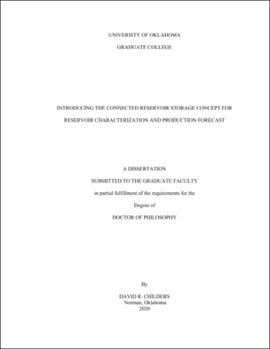| dc.description.abstract | This research presents a novel concept of the connected reservoir storage (CRSM) with which we can characterize the reservoir and accurately predict the production performance of hydrocarbon reservoirs, which have a complex reservoir geometry and have a considerable uncertainty of reservoir energy support. Based on the deconvolution of measured pressures and rate data from a well, both a liquid and gas reservoir performance can be modeled using a group of normalized quantities with which the behavior of the well can be accurately predicted in all flow regimes. No foreknowledge of reservoir geometries, petro-physical properties, or fluid properties is required to develop this analysis.
Reservoir storage is a time function defined as the product of the total compressibility and the reservoir volume at a particular time. Unlike with classical or curve fitting decline curve analysis, the CRSM is based on the pressure diffusivity theory by the normalized production rate and normalized cumulative production volume through deconvolution methods. With the knowledge of reservoir volumes, the long term well performance of liquid or gas reservoirs can be predicted. Through the development of the CRSM, three profiles can be ascertained and are interrelated to shed valuable insight into the production potential and health of a liquid or gas reservoir that exhibits complex formation geometries. The three curves are the reservoir response curve (RPC), normalized decline curve (NDC), and connected reservoir storage curve (CRSC). Utilizing the three curves stated above embodies a more powerful reservoir performance analysis technique for predicting the production potential of complex reservoirs.
The CRSM will be presented from the fundamental material balance approach and mathematical equations will be derived for the model related to both liquid and gas reservoir production. The CRSM concept will be validated through the development of numerical simulation models, conventional well application, with varying permeabilities, porosities and well geometries through the use of a reservoir simulation suite with known reservoir parameters and the utilization of deconvolution techniques to develop the CRSM. The CRSM will then be used to evaluate the reservoir response behavior to better approximate and characterize the flow and pressure behavior utilizing simulated production data of a bi-wing hydraulically fractured undersaturated oil reservoir, tight well application, and compare the CRSM to two classical forecasting methods. Additional studies using the CRSM will be applied to shale gas well performance comprised of a formation where the matrix is made up of very low permeable media (Kim and Lee, 2015). Moreover, this research will conclude by applying the CRSM to evaluate the reservoir response behavior to characterize the fracture network system in a shale gas reservoir with multi-stage hydraulic fracturing along the horizontal segment.
The application ability of the CRSM allows for the bridging of the production decline and reservoir pressure response from production data found in the public domain. This concept enables one to evaluate and forecast current and future volume production, reservoir pressure behavior, average reservoir pressure and determine original fluids in place with no prior knowledge of reservoir geometries, petro-physical or fluid properties. With the development of this model, decline curve analysis (DCA) can be extended into the transient regime of the production period. | en_US |
